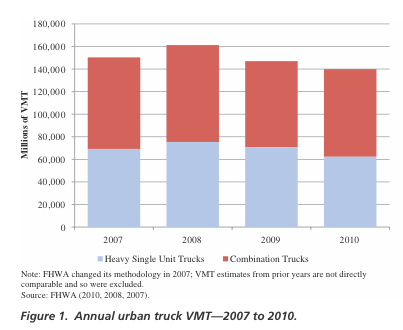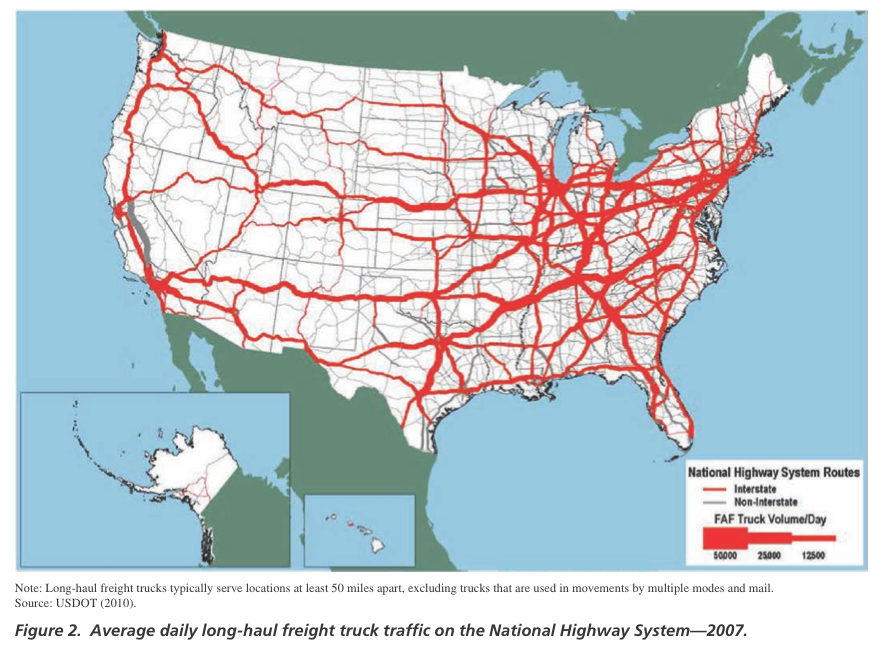NATIONAL COOPERATIVE FREIGHT RESEARCH PROGRAM
Current State of Knowledge of Urban Freight Flows and Their Impacts
Introduction
This section summarizes data on truck and van traffic and its impacts on metropolitan areas. First, a brief review of land use trends relevant to freight supply and demand in metropolitan areas provides some context. Second, the limited data on urban truck traffic is presented. Third, impacts are considered, including congestion, parking, and other circulation problems; crashes and safety; and air pollution and other environmental impacts. Finally, a brief overview of the European urban freight issues is presented as well as a summary of Task 1.
Congestion results in enormous costs to shippers, carriers, and the economy. According to the Texas A&M Transportation Institute (TTI), the total cost of truck congestion amounted to approximately $23 billion in 2010 for 439 U.S. urban areas (TTI, 2011, p. 1). Freight bottlenecks on highways throughout the United States cause more than 243 million hours of delay to truckers annually (FHWA, 2008). At a delay cost of $26.70 per hour, the conservative value used by FHWA’s Highway Economic Requirements System model for estimating national highway costs and benefits, these bottlenecks cost truckers about $6.5 billion per year (FHWA, 2008).
Over the past 25 years, freight transportation costs have declined, contributing significantly to enhanced productivity and economic growth. With ever-lower transportation costs, supply chains have become more complex and dispersed as firms along the chain substitute transport for lower cost inputs and higher product velocity. Prior to 2008, as economic activity was expanding, truck VMT was also on the rise. The recession has taken its toll on the growth rate of VMT. Figure 1 shows annual urban truck VMT from 2007 through 2010, defined as the sum of urban Interstate and other urban VMT by FHWA. VMT peaked in 2008 at 161 billion. By 2010, that figure dropped to less than 140 billion, a 13 percent drop. (2011 figures were not yet available when this study was undertaken.)
Despite the drop in VMT, congestion and bottlenecks continue to be a problem (see Section 1.3.3, Cambridge Systematics Bottleneck Studies). Much of the congestion problem is located in metropolitan areas, where trucks compete with passenger traffic in last-mile pick-up and delivery, freight trains compete with passenger rail (and all vehicular traffic at at-grade crossings), and where most major intermodal nodes are located.
Land Use Trends
 Land use trends are contributing to urban freight problems. There are two main trends: decentralization and consolidation. Logistics activities are decentralizing (i.e., moving away from the central city), in part due to rising land values as metropolitan areas grow. Freight facilities are also consolidating, in part due to increasing scale economies that require ever larger warehouse and distribution facilities. For example, consider a logistics firm that once had three small warehouses in the central city. The firm now has one large facility in a distant suburb. The move from the central city to the suburb represents the decentralization of the firm. The reduction from three smaller facilities to one large warehouse represents the consolidation.
Land use trends are contributing to urban freight problems. There are two main trends: decentralization and consolidation. Logistics activities are decentralizing (i.e., moving away from the central city), in part due to rising land values as metropolitan areas grow. Freight facilities are also consolidating, in part due to increasing scale economies that require ever larger warehouse and distribution facilities. For example, consider a logistics firm that once had three small warehouses in the central city. The firm now has one large facility in a distant suburb. The move from the central city to the suburb represents the decentralization of the firm. The reduction from three smaller facilities to one large warehouse represents the consolidation.
As logistics nodes both decentralize and consolidate activity, the effect on VMT is indeterminate. Decentralization may mean that pick-ups and deliveries require more truck VMT because the origin is further from most destinations. However, consolidation may lead to more efficient deliveries, reducing VMT. The VMT analysis is made more complex by the increase in just-in-time logistics. Just-in-time operations increase VMT because deliveries become smaller and thus more frequent. Some studies from France suggest that the net effect of decentralization and consolidation is greater VMT (Dablanc and Rakotonarivo, 2010; Dablanc and Andriankaja, 2011). While these trends may have a varying effect on VMT, we can say that logistics concentrations become hot spots of truck traffic and emissions (McKinnon, 1998).
An example of the impacts of economic growth and demand for land on the location of logistics activity can be seen in Atlanta, Georgia. Key freight corridors with access to the Interstate and major arterials are becoming prime space for high-density office and residential or mixed-use developments. These uses bid up prices. As a result, more and more logistics firms are moving their facilities to remote sites just outside of the metropolitan area where land prices are lower.
Logistics decentralization is happening all over the United States. Cidell (2010) shows that at the county level in 47 of the 50 largest U.S. metropolitan areas, a decentralization of freight activity occurred between 1986 and 2005, as measured via Gini coefficients. Looking at the zip code level, Dablanc and Ross (2012) have found that in Atlanta between 1998 and 2008, warehouses moved an average of 2.8 miles further away from their geographic centroid. During the same period, all business facilities for all types of activities in Atlanta moved an average of 1.3 miles, i.e., less than half the distance for logistics facilities. A similar trend has been observed in France in the Paris region. Dablanc and Rakotonarivo (2010) calculated that in Paris parcel and express transport companies, on average, locate their terminals 6.8 miles farther away from their geographic centroid today than in 1975, while businesses and shops have only moved 1.8 miles away during the same period. If routing or load economies (from consolidation or other factors) do not offset the increased distance between terminals and destinations, deliveries would require more truck miles traveled.
A study conducted by Shin and Kawamura (2006) revealed that the majority of national retail chains operate under the same type of supply chain system. Under this type of supply chain system, the company’s distribution centers are usually quite large, so they must be located far outside city limits where there is ample space to accommodate the buildings (Kawamura and Lu, 2007, p. 34). Delivery trucks must drive many miles to get packages from the distribution center to various parts of the city. Having one main distribution center that is located far from the city center also puts a large number of delivery trucks on the road network in urban areas (Kawamura and Lu, 2007, p. 34).
Read full report (PDF) here: Synthesis of Freight Research in Urban Transportation Planning
About TRB’s National Cooperative Freight Research Program (NCFRP)
www.trb.org/ncfrp
“America’s freight transportation system makes critical contributions to the nation’s economy, security, and quality of life. The freight transportation system in the United States is a complex, decentralized, and dynamic network of private and public entities, involving all modes of transportation—trucking, rail, waterways, air, and pipelines. In recent years, the demand for freight transportation service has been increasing fueled by growth in international trade; however, bottlenecks or congestion points in the system are exposing the inadequacies of current infrastructure and operations to meet the growing demand for freight. Strategic operational and investment decisions by governments at all levels will be necessary to maintain freight system performance, and will in turn require sound technical guidance based on research.”
Tags: NCFRP, planning, Synthesis of Freight Research in Urban Transportation Planning, TRB







 RSS Feed
RSS Feed